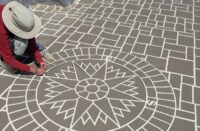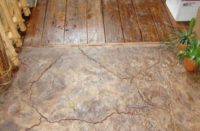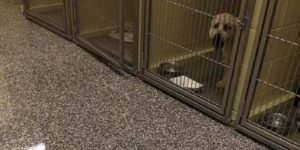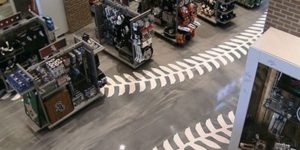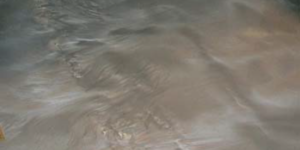As metallic coatings grow in popularity, the competition is heating up. Bear in mind that the key to a mesmerizing metallic floor is the artist behind it.
Unlike a solid or chip system, metallics produce floors that are one of a kind. Installers each have their own ways of applying metallics, so I stress to potential customers that it’s not a system they can easily shop around for pricing. If they like a contractor’s work, they should go with that person because another installer won’t be able to replicate that artwork. Metallic floors can be applied in many ways. There is no right or wrong way, and each artist/installer will have his or her own style.
As I have said in the past and will say again, every metallic floor is unique. While I can copy the colors used in one of my projects, even I can’t precisely reproduce the metallics’ movement for the outcome.
No clones here
Metallic epoxy floor coatings continue to be popular choices where a high-tech, exotic-looking floor is desired. Essentially, they comprise mica pigments added to clear epoxy as opposed to pigmented epoxy. The pigments are designed to be dispersed in a variety of binders to produce a unique three-dimensional appearance with the color or colors showing through. Because the product is a clear epoxy, the result can end up being very translucent.
There is a certain amount of natural variation in the finished product’s appearance from job to job, which makes no two jobs identical. It’s this fact that each floor is noticeably different that makes the product so desirable.

Be advised that with metallic epoxy flooring, imperfections make the floor! Each floor will vary in look inch by inch. Although the floors shown on my website and Facebook page are floors I’ve done, I cannot duplicate them. If clients see one they like, the best I can do is give them the same coloring and overall look. If clients want a perfect floor with consistency throughout, this is not the system for them.
You can use just a single color or multiple colors to create a glossy floor with depth and a variety of visual effects. I recommend using no more than three colors or the look gets too busy. Some applications can create a beautiful three-dimensional appearance that gives the illusion of acid stain, craters, ripples and swirling rivers of metallic-looking plasma. If you’re going for more of an acid stain look, skip the solvents.
Solvents add movement
To help achieve a three-dimensional look and create movement, I always squeegee the entire floor and use solvents to disperse the pigment. The effects can range from soft and subtle changes in color, to a more distinctive hammered/cratered look.
The solvents I prefer are xylene, denatured alcohol or MEK (methyl ethyl ketone). I always use the same solvent on a project depending on the look I’m trying to achieve and never mix them during an application. Different solvents will create different looks so you need to experiment to determine what produces what.

Besides solvent selection, timing is critical. If I want to get a crater look I wait until the floor is tacky to apply the solvent. If I touch the floor with my finger and it leaves an indentation, then it’s ready to go. If the floor is too wet when the solvent is put down, the material will flood back and you will lose much of the “hammered” effect.
You can use a variety of solvents to achieve a cloud-like look. You don’t want to put a solvent on the floor when the epoxy is too tacky. A lot of what the finish looks like is determined by the high and low spots of the floor as gravity pulls the product as it dries and cures.
The drying process
After a metallic coating is down, the metallic epoxy product remains in flux. The applied metallic epoxy product will move in the direction of any slope in the concrete substrate while drying. So that “swirling river” effect you sometimes see has more to do with gravity than preconceived artistic movement.
All concrete substrates have some slope and inconsistencies that will affect the movement of the product while it’s drying. Therefore, there may be some variance in the appearance of the application from the time the installer completes the application and leaves the job site, and when the product finally dries. This variance is out of any installer’s control.
In other words: Your effects will continuously change until the floor completely dries.
Blemishes may show
All concrete surfaces have blemishes and cracks. You should patch all the ones you see before applying a metallic system, but you will probably miss some. Because of the high-gloss, transparent epoxy used in metallic floors, unnoticed blemishes and cracks in the underlying concrete surface might become apparent after applying the metallic epoxy product.

You should let clients know a metallic epoxy floor is not guaranteed to conceal pre-existing blemishes in the concrete surface. These blemishes would normally not be visible with a chip floor. While metallic floors look amazing, a chip system is forgiving.
Metallic floors are one of the most durable systems on the market because they’re done with 100 percent solids. But because of their high-gloss finish, they are also a lot more susceptible to scratches. There’s a difference between impact durability and scratch resistance.
Upkeep is important
With their high-gloss finish, metallic floors are very susceptible to scratches. It’s not a matter of if it will be scratched, it’s just a matter of when.
For exterior residential jobs, such as garages which comprise the bulk of my metallic business, I always use polyurethane. It offers the best scratch and UV protection for metallic coatings.
For retail and residential interior jobs, I recommend applying four layers of wax for protection. This way scratches will be imbedded in the wax and not the floor. Whenever the floor is stripped and rewaxed, it will look brand new again.

Steel and Emerald Green garage floor.

